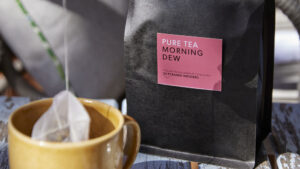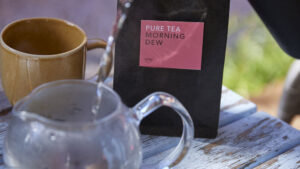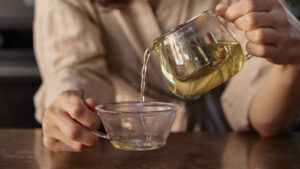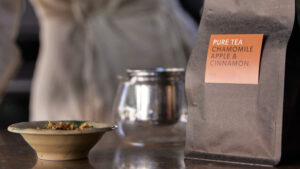Best way to store tea
If you’re wanting the best cup of tea, you should be storing your tea properly! Read further to discover how you should store your tea leaves.
Tea can last years and years as long as your tea leaves are stored correctly. If tea leaves are left casually loose and open, it can result in flavour deterioration and a stale tasting cuppa.
For a fresh cup of tea, you need to keep your tea fresh. Read further to discover the best ways to store your tea so you can maintain freshness and enjoy good tea with every brew.
Storing tea – does it matter?
If you’ve only ever stored your tea bags or loose teas in open tea boxes or tea bags, then you quite possibly have never enjoyed fresh tea before. Once you switch up your routine and begin storing tea bags and loose leaf tea properly, you will never go back. The fresh, full flavour is simply impossible to beat!
Tea, just like coffee, relies on a stable environment to preserve the tea. Leaving loose tea leaves open, makes them susceptible to changing weather conditions, air exposure and odours.
If you’re wondering, does it matter how you store your tea? The short answer is – yes. Storing your tea plays an important role in what your tea will taste like and how long your tea will last. Storing incorrectly results in poor quality tea. And, life’s way too short for a cup of tea anything short of delicious.
Common causes of reduced shelf life
Maintaining the moisture content of the tea leaves is essential in increasing the tea leaves’ shelf life. Whilst excess moisture can result in bacteria growth. Losing moisture can result in the tea leaves becoming stale. What causes moisture changes in the tea leaves are environmental changes.
Environmental changes can result in:
- Ethylene exposure – alters the make-up of the tea leaves and can cause withering.
- Temperature changes – ideally, you want the temperature of the tea leaves to never change.
- Humidity/moisture – a humid environment or dry environment will result in moisture changes in the tea leaves and can quicken the oxidation process.
- Microbial growth – when microorganisms grow in the tea or the tea packaging. If the tea is stored in cardboard, this could be more likely.
- Physical harm/damage – make sure your tea leaves are stored safely to avoid breakage of the tea leaves themselves.
How to not store your tea
There’s the misconception that tea can be stored in a loose box or bag and put anywhere on a home kitchen counter. Even though this is a popular way to store tea, it’s not the best method. In fact, there are many popular yet problematic ways to store tea that we don’t encourage.
Tea storage to avoid:
- Open boxes or bags that’s aren’t air tight. It’s ok to keep your tea in the tea packaging it’s bought in. However, only if that packaging can be sealed properly.
- Fridge or freezer. We understand that you might be tempted to store your tea in the freezer as it’s a cool place that might preserve your tea. However, we would advise against this as it’s changing the environment of the tea. Especially if you’re regularly taking the tea in and out from the fridge to the kitchen – your tea is getting quite the climatic workout.
- Tea cabinet. Having a cabinet dedicated to your tea collection sounds like a dream kitchen to us! However, you will still need to store loose tea and tea bags properly. A tea cabinet alone won’t keep your tea fresh.
- In a tea tin. This might sound odd, but a great deal of cute and quirky tea tins aren’t efficient means of storing tea. Many tea tins, glass jars or old tea canisters don’t close or seal properly, allowing for air to easily seep in. You need to be careful in choosing your tea storage to avoid storing tea incorrectly.
Proper storage for your tea
Are you ready to change your tea drinking forever? Ok good. Grab your pen and paper and make note of these best ways to store tea.
How to store your tea:
- Purchase premium quality tea leaves from a tea supplier. If you’re buying the quick and easy tea from the supermarket, there’s a high chance that this tea is already stale. As cheap tea is mass produced, maintaining quality is generally not a concern for those along the supply chain. High quality tea has a transparent supply chain, prioritising freshness of the tea leaves every step of the way.
- Transfer your tea leaves and tea bags. The packaging you purchase your tea leaves in should be in an airtight bag or airtight container. Once you’ve opened the packaging, if you can’t reseal the packaging to be airtight again, it’s best to transfer your tea to a different container.
- Storing your tea. The best way to store your loose leaf tea or tea bags is in a high quality airtight container. An airtight container will prevent any changes to the tea caused by humidity, environmental damage or weather conditions. We recommend a durable and airtight stainless steel container.
- Place in a dark cupboard. Now that your teas are stored safely in their airtight containers, pop the teas in a dark cupboard. This could be in your pantry or in a special drawer. This will prevent light and odours from affecting your tea leaves.
How to tell if your tea is fresh
If you’re unsure if your loose leaf tea is fresh, you’ll be able to tell by either smelling, touching or tasting your tea. If you find that your tea has a stale taste, smells dusty or breaks away easily in your hands then your tea is old. Stale loose leaf tea or tea bags aren’t ideal to drink and can make individuals sick depending on how old the tea is.
Tea forever
Increase the shelf life on your tea by storing tea correctly! Once you’ve enjoyed a cup of fresh tea, you’ll never want to go back to your old ways. Plus, the feeling you get from looking at your organised tea blends in their containers is oh-so satisfying… or maybe that’s just us?
If you’re looking for fresh loose leaf tea or tea bags to add to your tea drawer, we are fortunate enough to supply Pure Tea to customers across Australia. Choose from green teas, black teas, tisanes and more! There’s no such thing as too many teas.
We hope you enjoyed reading this blog on how to store tea bags and loose leaf tea. If you have further questions, feel free to contact us or reach out to our Instagram @puretea_australia.
Until next time,
Pure Tea team







